Global 4D Printing Market, By Material Type, By End User, By Region & Segmental Insights Trends and Forecast, 2024 – 2034
- Industry: Technology
- Report ID: TNR-110-1208
- Number of Pages: 420
- Table/Charts : Yes
- July, 2024
- Base Year : 2024
- No. of Companies : 10+
- No. of Countries : 29
- Views : 10213
- Covid Impact Covered: Yes
- War Impact Covered: Yes
- Formats : PDF, Excel, PPT
4D printing is an advanced form of additive manufacturing where printed objects can change their shape or properties over time in response to external stimuli such as heat, light, or moisture. This technology is set to revolutionize various industries by introducing dynamic and adaptable materials. The 4D printing market is experiencing significant growth, driven by innovations in material science and increasing demand for smart materials.
Industries such as aerospace, healthcare, and automotive are exploring the potential of 4D printing for creating self-assembling components, medical implants, and adaptive infrastructure. The growing emphasis on sustainability is also propelling the market, as 4D printed materials can reduce waste and improve product lifecycle management. Key opportunities lie in the development of advanced materials and the integration of 4D printing with Internet of Things (IoT) technologies to create intelligent systems.
The primary growth drivers of the 4D printing market include technological advancements in 3D printing and material science, increased funding for research and development, and the rising demand for innovative and customizable products. Additionally, the growing need for efficient and adaptive solutions in various sectors, such as healthcare, aerospace, and construction, is fueling market expansion. The ability of 4D printing to provide cost-effective and sustainable manufacturing solutions is further accelerating its adoption across industries. In Terms of Revenue, the Global 4D Printing Market was Worth US$ 1.1 Bn in 2023, Anticipated to Witness CAGR of 17.4% During 2024 – 2034.
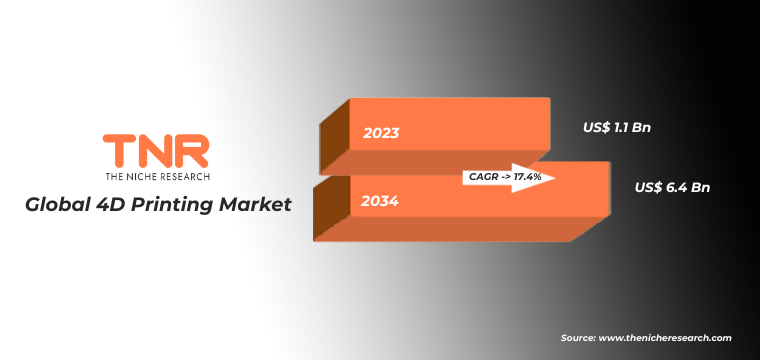
Trends in the Global 4D Printing Market
- Integration with Smart Materials: One of the most significant trends in the 4D printing market is the integration with smart materials. These materials, also known as programmable or responsive materials, change their properties in response to environmental stimuli such as temperature, humidity, or light. This integration is opening new possibilities for creating adaptive and self-healing structures. For instance, in the healthcare sector, 4D printing can be used to develop implants that adjust to the body’s changing conditions, enhancing patient outcomes. In the aerospace industry, components that self-assemble or repair themselves can reduce maintenance costs and increase efficiency. The continuous advancement in material science is expanding the range of smart materials available for 4D printing, driving innovation and broadening the applications of this technology across various industries.
- Sustainability and Environmental Impact: As industries worldwide aim to minimize waste and energy consumption, 4D printing offers promising solutions. The technology’s ability to create dynamic, multi-functional materials can lead to significant resource savings. For example, construction materials that adapt to environmental conditions can enhance energy efficiency in buildings, while packaging that changes properties can improve product shelf life and reduce waste. Moreover, the potential for 4D printed materials to undergo shape transformation reduces the need for multiple manufacturing processes, leading to lower carbon emissions. The alignment of 4D printing with global sustainability goals is driving its adoption and fostering investment in research and development to explore new eco-friendly applications.
Programmable carbon fiber by material type category has emerged as a dominant segment in the global 4D printing market, due to its exceptional properties and versatile applications.
Known for its high strength-to-weight ratio, durability, and resistance to environmental factors, carbon fiber is an ideal material for advanced manufacturing processes. When combined with 4D printing technology, programmable carbon fiber can produce components that change shape or function in response to specific stimuli, unlocking new possibilities across various industries. In aerospace, programmable carbon fiber is revolutionizing the production of lightweight, self-assembling structures that can adapt to different flight conditions, thereby enhancing performance and fuel efficiency.
In the automotive sector, this material is used to create components that improve vehicle aerodynamics and safety. The construction industry also benefits from programmable carbon fiber, as it can be used to develop adaptive building materials that respond to environmental changes, promoting energy efficiency and sustainability. The medical field is exploring the use of programmable carbon fiber for creating customized, patient-specific implants and prosthetics that adjust to the body’s movements, improving comfort and functionality. The growing demand for innovative, high-performance materials and the continuous advancements in material science and 4D printing technology are propelling the dominance of programmable carbon fiber in the market, making it a crucial element in the future of manufacturing.
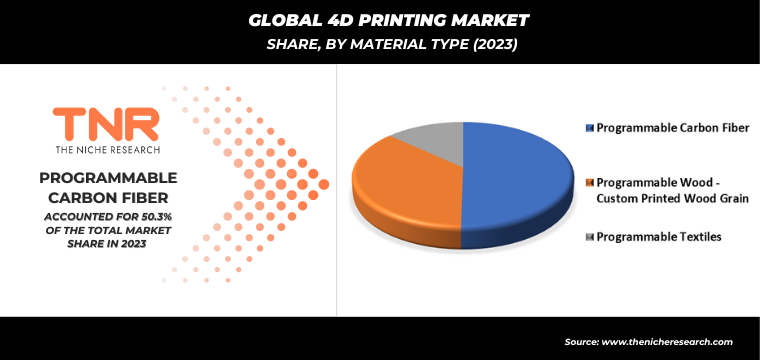
In 2023, automotive segment solidified its position as the second-largest end user category within the global 4D printing market.
The sector’s embrace of 4D printing technology has been driven by the need for innovative solutions to enhance vehicle performance, safety, and sustainability. 4D printing allows automotive manufacturers to create parts that can respond to environmental changes, leading to the development of adaptive, smart components that improve efficiency and functionality. One key application of 4D printing in the automotive industry is the production of self-healing materials. These materials can repair minor damages autonomously, reducing maintenance costs and increasing the lifespan of vehicle components. 4D printed parts can adapt their shape or stiffness in response to driving conditions, optimizing aerodynamics and fuel efficiency.
This adaptability also extends to interior elements, where components can change to enhance comfort and usability. The integration of 4D printing technology supports the automotive industry’s goals of reducing weight and improving the sustainability of vehicles. Lighter, more adaptable parts contribute to lower emissions and better fuel economy. The customization potential of 4D printing allows manufacturers to offer tailored solutions, meeting specific customer needs and preferences. As the automotive industry continues to prioritize innovation and efficiency, the adoption of 4D printing is expected to grow, further cementing its role as a critical player in the market.
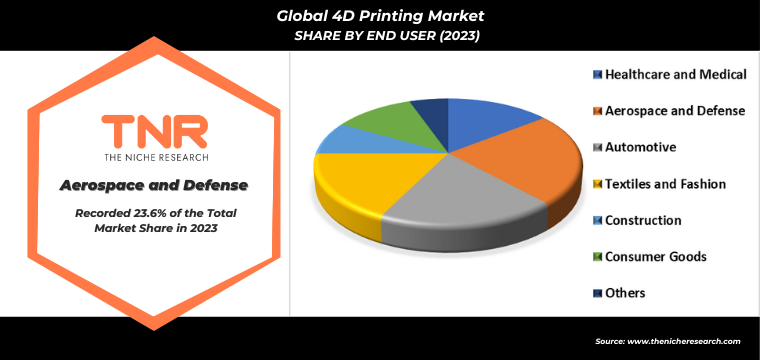
In 2023, North America solidified its dominance in the global 4D printing market, contributing a revenue share of 36.8%.
This leadership position is attributed to several factors, including the region’s robust technological infrastructure, significant investment in research and development, and a strong presence of key industry players. The United States, in particular, has been at the forefront of 4D printing innovation, driven by its advanced manufacturing sector and a focus on cutting-edge technologies. Major universities and research institutions in North America have played a crucial role in advancing 4D printing technologies, fostering collaborations between academia and industry to accelerate the development and commercialization of new applications.
In addition, North America’s thriving aerospace and automotive industries have been early adopters of 4D printing, leveraging its potential to create smart materials and adaptive components. The aerospace sector utilizes 4D printing to produce self-assembling and self-repairing structures, while the automotive industry benefits from the development of parts that enhance vehicle performance and safety. Government support and favorable regulatory frameworks have also contributed to North America’s leading position in the market. Initiatives aimed at promoting advanced manufacturing technologies and sustainable practices have encouraged the adoption of 4D printing across various industries. As a result, North America is expected to maintain its market leadership, continuing to drive innovation and growth in the 4D printing sector.
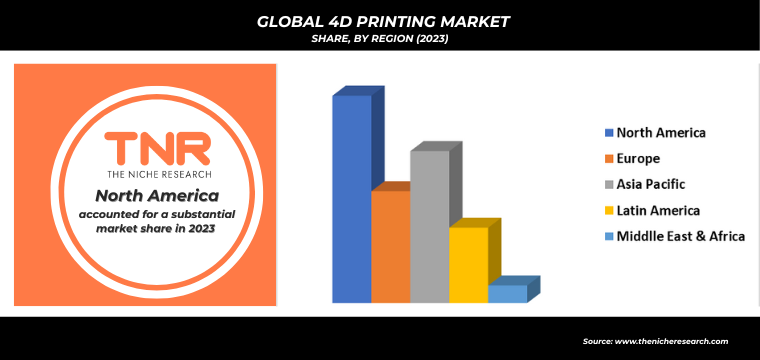
Competitive Landscape
Some of the players operating in the 4D printing market are
- 3D Systems Inc
- Aerojet Rocketdyne Holdings Inc.
- ARC Centre of Excellence for Electromaterials Science (ACES)
- Autodesk, Inc
- Dassault Systèmes
- Engineering & Manufacturing Services Inc
- ExOne Corporation
- Heineken NV
- Hewlett Packard Corp.
- Materialise NV
- Norsk Titanium US Inc
- Organovo Holdings, Inc.
- Stratasys Ltd
- Other Industry Participants
Global 4D Printing Market Scope
| Report Specifications | Details |
| Market Revenue in 2023 | US$ 1.1 Bn |
| Market Size Forecast by 2034 | US$ 6.4 Bn |
| Growth Rate (CAGR) | 17.4% |
| Historic Data | 2019 – 2022 |
| Base Year for Estimation | 2023 |
| Forecast Period | 2024 – 2034 |
| Report Inclusions | Market Size & Estimates, Market Dynamics, Competitive Scenario, Trends, Growth Factors, Market Determinants, Key Investment Segmentation, Product/Service/Solutions Benchmarking |
| Segments Covered | By Material Type, By End User, By Region |
| Regions Covered | North America, Europe, Asia Pacific, Middle East & Africa, Latin America |
| Countries Covered | U.S., Canada, Mexico, Rest of North America, France, The UK, Spain, Germany, Italy, Nordic Countries (Denmark, Finland, Iceland, Sweden, Norway), Benelux Union (Belgium, The Netherlands, Luxembourg), Rest of Europe, China, Japan, India, New Zealand, Australia, South Korea, Southeast Asia (Indonesia, Thailand, Malaysia, Singapore, Rest of Southeast Asia), Rest of Asia Pacific, Saudi Arabia, UAE, Egypt, Kuwait, South Africa, Rest of Middle East & Africa, Brazil, Argentina, Rest of Latin America |
| Key Players | 3D Systems Inc, Aerojet Rocketdyne Holdings Inc., ARC Centre of Excellence for Electromaterials Science (ACES), Autodesk, Inc, Dassault Systèmes, Engineering & Manufacturing Services Inc, ExOne Corporation, Heineken NV, Hewlett Packard Corp., Materialise NV, Norsk Titanium US Inc, Organovo Holdings, Inc., Stratasys Ltd |
| Customization Scope | Customization allows for the inclusion/modification of content pertaining to geographical regions, countries, and specific market segments. |
| Pricing & Procurement Options | Explore purchase options tailored to your specific research requirements |
| Contact Details | Consult With Our Expert
Japan (Toll-Free): +81 663-386-8111 South Korea (Toll-Free): +82-808- 703-126 Saudi Arabia (Toll-Free): +966 800-850-1643 United Kingdom: +44 753-710-5080 United States: +1 302-232-5106 E-mail: askanexpert@thenicheresearch.com
|
Global 4D Printing Market
By Material Type
- Programmable Carbon Fiber
- Programmable Wood – Custom Printed Wood Grain
- Programmable Textiles
By End User
- Healthcare and Medical
- Aerospace and Defense
- Automotive
- Textiles and Fashion
- Construction
- Consumer Goods
- Others
By Region
- North America (U.S., Canada, Mexico, Rest of North America)
- Europe (France, The UK, Spain, Germany, Italy, Nordic Countries (Denmark, Finland, Iceland, Sweden, Norway), Benelux Union (Belgium, The Netherlands, Luxembourg), Rest of Europe)
- Asia Pacific (China, Japan, India, New Zealand, Australia, South Korea, Southeast Asia (Indonesia, Thailand, Malaysia, Singapore, Rest of Southeast Asia), Rest of Asia Pacific)
- Middle East & Africa (Saudi Arabia, UAE, Egypt, Kuwait, South Africa, Rest of Middle East & Africa)
- Latin America (Brazil, Argentina, Rest of Latin America)
Report Layout:
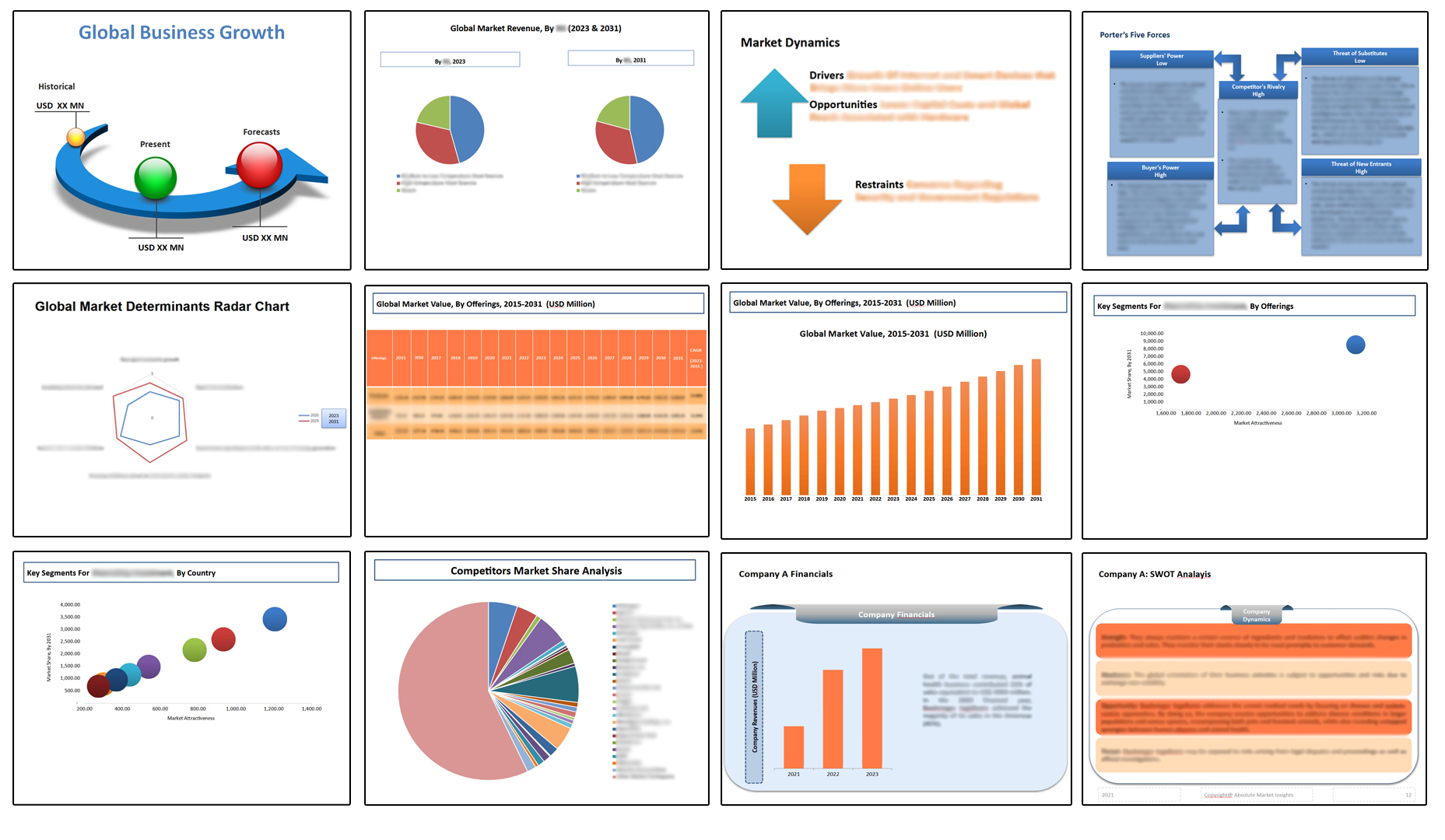
Table of Contents
Note: This ToC is tentative and can be changed according to the research study conducted during the course of report completion.
**Exclusive for Multi-User and Enterprise User.
Global 4D Printing Market
By Material Type
- Programmable Carbon Fiber
- Programmable Wood – Custom Printed Wood Grain
- Programmable Textiles
By End User
- Healthcare and Medical
- Aerospace and Defense
- Automotive
- Textiles and Fashion
- Construction
- Consumer Goods
- Others
By Region
- North America (U.S., Canada, Mexico, Rest of North America)
- Europe (France, The UK, Spain, Germany, Italy, Nordic Countries (Denmark, Finland, Iceland, Sweden, Norway), Benelux Union (Belgium, The Netherlands, Luxembourg), Rest of Europe)
- Asia Pacific (China, Japan, India, New Zealand, Australia, South Korea, Southeast Asia (Indonesia, Thailand, Malaysia, Singapore, Rest of Southeast Asia), Rest of Asia Pacific)
- Middle East & Africa (Saudi Arabia, UAE, Egypt, Kuwait, South Africa, Rest of Middle East & Africa)
- Latin America (Brazil, Argentina, Rest of Latin America)
The Niche Research approach encompasses both primary and secondary research methods to provide comprehensive insights. While primary research is the cornerstone of our studies, we also incorporate secondary research sources such as company annual reports, premium industry databases, press releases, industry journals, and white papers.
Within our primary research, we actively engage with various industry stakeholders, conducting paid interviews and surveys. Our meticulous analysis extends to every market participant in major countries, allowing us to thoroughly examine their portfolios, calculate market shares, and segment revenues.
Our data collection primarily focuses on individual countries within our research scope, enabling us to estimate regional market sizes. Typically, we employ a bottom-up approach, meticulously tracking trends in different countries. We analyze growth drivers, constraints, technological innovations, and opportunities for each country, ultimately arriving at regional figures.Our process begins by examining the growth prospects of each country. Building upon these insights, we project growth and trends for the entire region. Finally, we utilize our proprietary model to refine estimations and forecasts.
Our data validation standards are integral to ensuring the reliability and accuracy of our research findings. Here’s a breakdown of our data validation processes and the stakeholders we engage with during our primary research:
- Supply Side Analysis: We initiate a supply side analysis by directly contacting market participants, through telephonic interviews and questionnaires containing both open-ended and close-ended questions. We gather information on their portfolios, segment revenues, developments, and growth strategies.
- Demand Side Analysis: To gain insights into adoption trends and consumer preferences, we reach out to target customers and users (non-vendors). This information forms a vital part of the qualitative analysis section of our reports, covering market dynamics, adoption trends, consumer behavior, spending patterns, and other related aspects.
- Consultant Insights: We tap into the expertise of our partner consultants from around the world to obtain their unique viewpoints and perspectives. Their insights contribute to a well-rounded understanding of the markets under investigation.
- In-House Validation: To ensure data accuracy and reliability, we conduct cross-validation of data points and information through our in-house team of consultants and utilize advanced data modeling tools for thorough verification.
The forecasts we provide are based on a comprehensive assessment of various factors, including:
- Market Trends and Past Performance (Last Five Years): We accurately analyze market trends and performance data from preceding five years to identify historical patterns and understand the market’s evolution.
- Historical Performance and Growth of Market Participants: We assess the historical performance and growth trajectories of key market participants. This analysis provides insights into the competitive landscape and individual company strategies.
- Market Determinants Impact Analysis (Next Eight Years): We conduct a rigorous analysis of the factors that are projected to influence the market over the next eight years. This includes assessing both internal and external determinants that can shape market dynamics.
- Drivers and Challenges for the Forecast Period:Identify the factors expected to drive market growth during the forecast period, as well as the challenges that the industry may face. This analysis aids in deriving an accurate growth rate projection.
- New Acquisitions, Collaborations, or Partnerships: We keep a close watch on any new acquisitions, collaborations, or partnerships within the industry. These developments can have a significant impact on market dynamics and competitiveness.
- Macro and Micro Factors Analysis:A thorough examination of both macro-level factors (e.g., economic trends, regulatory changes) and micro-level factors (e.g., technological advancements, consumer preferences) that may influence the market during the forecast period.
- End-User Sentiment Analysis: To understand the market from the end-user perspective, we conduct sentiment analysis. This involves assessing the sentiment, preferences, and feedback of the end-users, which can provide valuable insights into market trends.
- Perspective of Primary Participants: Insights gathered directly from primary research participants play a crucial role in shaping our forecasts. Their perspectives and experiences provide valuable qualitative data.
- Year-on-Year Growth Trend: We utilize a year-on-year growth trend based on historical market growth and expected future trends. This helps in formulating our growth projections, aligning them with the market’s historical performance.
Research process adopted by TNR involves multiple stages, including data collection, validation, quality checks, and presentation. It’s crucial that the data and information we provide add value to your existing market understanding and expertise. We have also established partnerships with business consulting, research, and survey organizations across regions and globally to collaborate on regional analysis and data validation, ensuring the highest level of accuracy and reliability in our reports.









